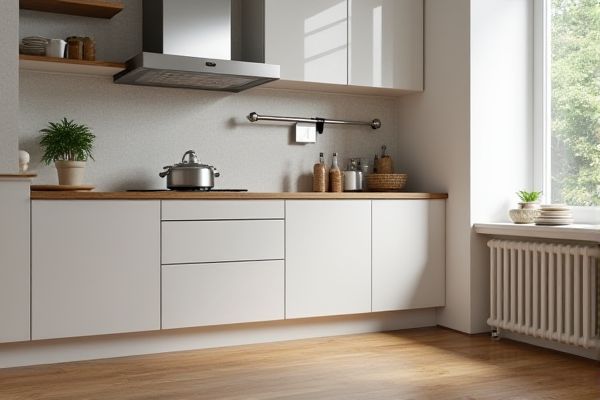
Drawer base cabinets offer easy access and organization for your kitchen essentials, while door base cabinets provide ample storage space for larger items. Explore the differences and benefits to determine which option best suits your storage needs.
Table of Comparison
| Feature | Drawer Base Cabinets | Door Base Cabinets |
|---|---|---|
| Accessibility | Easy access to contents with full extension drawers | Access limited to cabinet opening; items may require bending |
| Storage Organization | Better organization with multiple compartments and dividers | Less organized, open shelf storage inside |
| Installation Cost | Higher cost due to hardware and drawer mechanisms | Lower initial cost, simpler installation |
| Durability | More moving parts can require maintenance | Fewer moving parts, generally more durable |
| Space Utilization | Efficient use of space, maximizes storage volume | Less efficient, wasted space behind doors |
| Ideal Use | Best for small items, utensils, and tools | Best for large pots, pans, and bulkier items |
| Design Flexibility | Modern look with customizable drawer fronts | Traditional design, easy to match existing cabinetry |
Introduction to Drawer and Door Base Cabinets
Drawer base cabinets provide organized storage with multiple pull-out compartments, ideal for easy access to utensils and smaller items. Door base cabinets offer larger, open spaces behind hinged doors, perfect for storing bulkier kitchenware and appliances. Understanding your kitchen layout helps you determine whether drawer or door base cabinets best suit your storage needs and workflow.
Key Differences Between Drawer and Door Base Cabinets
Drawer base cabinets provide organized storage with easy access to smaller items through multiple pull-out compartments, while door base cabinets offer larger, open spaces ideal for storing bulky items such as pots and pans. Drawers maximize visibility and accessibility for kitchen utensils, whereas doors typically require reaching inside, making drawer cabinets more ergonomic for frequently used items. Material choices, installation methods, and customization options further differentiate drawer base cabinets from door base cabinets in kitchen design.
Space Utilization: Drawers vs Door Cabinets
Drawer base cabinets maximize space utilization by providing easy access to the entire cabinet interior, allowing for organized storage of utensils, pots, and pans without deep bending. Door base cabinets often feature shelves that can lead to wasted space in corners and less accessible items stored at the back. Efficient use of storage space favors drawers for frequent item retrieval and door cabinets for larger, less frequently used equipment.
Accessibility and Convenience
Drawer base cabinets provide superior accessibility by allowing you to pull out the entire contents, making it easy to reach items stored at the back without bending or straining. Door base cabinets typically require you to open the door and reach into a fixed space, which can be less convenient, especially for deeper cabinets. For maximum convenience and efficient use of space, drawer cabinets enhance organization and reduce retrieval time, improving your overall kitchen workflow.
Aesthetics and Design Options
Drawer base cabinets offer sleek, modern aesthetics with clean horizontal lines that create a streamlined look in your kitchen, while door base cabinets provide traditional appeal with versatile panel designs and customizable finishes. You can choose drawer bases for easy access and a contemporary vibe or door bases for a classic style with ample interior storage options that accommodate various organization needs. Both cabinet types come in a wide array of colors, materials, and hardware choices, allowing you to tailor your kitchen design to your personal taste and overall decor theme.
Kitchen Organization Efficiency
Drawer base cabinets enhance kitchen organization efficiency by providing easy access and better visibility to stored items, minimizing the need to bend or reach deep inside. Door base cabinets often require stacking or additional organizers to prevent clutter, slowing down retrieval times. Optimal kitchen workflows are supported by strategically combining drawer and door base cabinets to maximize storage accessibility and space utilization.
Cost Comparison
Drawer base cabinets typically cost more than door base cabinets due to the complexity of drawer slides and hardware. Door base cabinets use simpler construction methods, resulting in lower overall material and labor expenses. Choosing door base cabinets offers a more budget-friendly option without sacrificing essential storage functionality.
Maintenance and Durability
Drawer base cabinets typically require more maintenance due to moving parts like slides and rollers, which can wear out or misalign over time. Door base cabinets have fewer mechanical components, making them generally more durable and easier to maintain. When choosing between the two, consider your kitchen's usage and whether you prioritize ease of access or long-term durability for your cabinetry.
Best Use Cases for Each Cabinet Type
Drawer base cabinets excel in organizing smaller kitchen items, such as utensils, pots, and pans, offering easy access and maximizing storage efficiency, making them ideal for busy kitchens with frequent cooking activities. Door base cabinets suit larger items like baking sheets, cutting boards, and bulky cookware, providing deep storage space and flexibility for storing irregularly shaped goods, perfect for kitchens with fewer but larger utensils. Choosing between drawer and door base cabinets depends on kitchen layout, user preferences, and the types of items frequently used during meal preparation.
Choosing the Right Base Cabinet for Your Kitchen
Drawer base cabinets provide easy access and organization for utensils, pots, and pans, making them ideal for busy kitchens requiring efficient storage solutions. Door base cabinets offer versatile storage with adjustable shelves, suitable for accommodating larger items and appliances. Selecting the right base cabinet depends on kitchen layout, storage needs, and convenience preferences to enhance functionality and maximize space.
 homyna.com
homyna.com